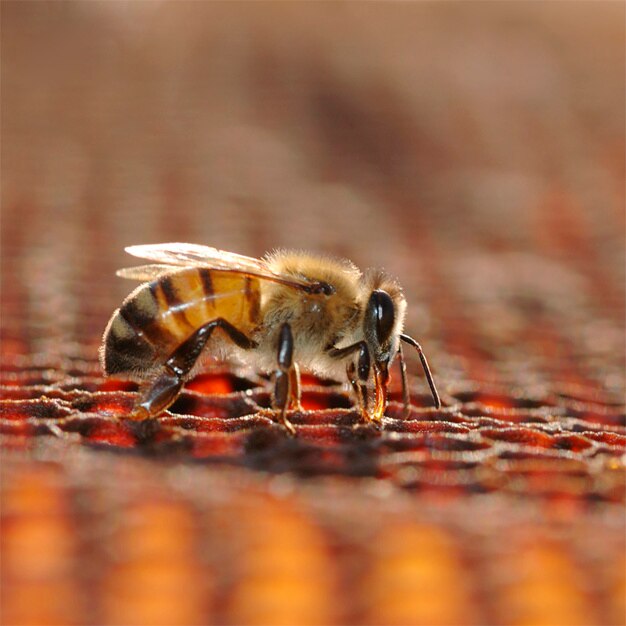Bees play a crucial role in ecosystems, pollinating plants essential for food and shelter for countless species, including humans. Their work highlights their significance to biodiversity and agriculture worldwide. This connects them deeply to our planet’s wellbeing.
Exploring the bee world, we find over 20,000 known bee species. This diversity ranges from communal honeybees to solitary species. Each species is adapted to unique roles in their ecosystems. Although the honeybee is well-known for its social structure and honey production, the variety among bee species is vast.
This diversity shows bees’ adaptability and resilience. Bees pollinate many crops, including apples, almonds, watermelons, blueberries, and cherries. These crops, pollinated by bees native to Wisconsin in the case of some, have high global production volumes. The work of bees is indispensable for sustaining wild flora and agricultural productivity.
Understanding the Diversity of Bees
Main Types of Bees
Bees display an incredible diversity, with over 20,000 known species worldwide. About 4,000 of these are native to the United States. The primary groups of bees or classes of bees include honey bees, bumblebees, and solitary bees.
- Honey Bees (Apis mellifera), a prime example of honey bee description and types: Honey bees are well-known for producing honey. They form structured social colonies. These include a queen, worker bees, and drones. Worker bees are responsible for hive cleaning, repair, brood nursing, and foraging for food and water. They also handle honey creation and hive guarding. Drones’ sole purpose is to mate with a virgin queen. The queen lays eggs, regulates hive activity through pheromones, and initiates swarming to create new hives.
- Bumblebees (Bombus): Bumblebees are plump and fuzzy insects known for efficient pollination. They form smaller, annual colonies. Significant bumblebee populations are found in North America, the UK, Europe, China, and South America.
- Solitary Bees, including the thin bee and bee with long back legs types: This category includes species like Adrena spp. and Panurginus spp.. Unlike social bees, solitary bees do not live in colonies. They are efficient pollinators and vary greatly in appearance and nesting behaviors.
Bee-pollinated crops contribute significantly to our diets. They account for about one-third of the human dietary supply.
Unique and Noteworthy Species
Some bee species, such as the black and white bee are particularly unique due to their habits, appearances, or environmental contributions:
- Wallace’s Giant Bee (Megachile pluto): The largest known bee species, found in Indonesia. It highlights the size diversity among bees.
- Sweat Bees (Halictidae), a group of docile bees: These bees are attracted to human sweat. They have a metallic sheen and can be green, red, yellow, or black. Their stings are relatively painless compared to other bees.
- Carpenter Bees: Recognizable by their shiny, hairless abdomens. They nest in softwoods. While they can damage wooden structures, they are important pollinators.
- Leafcutter Bees: Leafcutter bees are among the most efficient pollinators. They are particularly valuable to the alfalfa seed industry.
- Parasitic Bees: Includes species like the cuckoo bee. These bees lay their eggs in the nests of other bees. They do not collect pollen or contribute directly to pollination.
Identifying Bees: Tips and Techniques
Recognizing the variety in your backyard or community garden can greatly enhance your understanding of these pollinators. However, it’s important to highlight that some bee species are endangered, including:
- Hylaeus anthracinus
- Hylaeus longiceps
- Hylaeus assimulans
- Hylaeus facilis
- Hylaeus hilaris
- Hylaeus kuakea
- Hylaeus mana
- Rusty patched bumble bee
Bee distribution patterns vary globally. The highest diversity is in the Northern Hemisphere, with specific concentration areas like South Africa. Records in developing countries are often sparse and inaccurate. Below is an overview of global bee distribution:
| Region | Number of Species | Characteristics |
|---|---|---|
| Northern Hemisphere | Higher diversity | Prefer temperate regions over the tropics |
| South Africa | Center of diversity | Winter rainfall area and early to mid-summer rainfall area are key centers of endemism |
| Developing countries | Sparse records | Frequently inaccurate data |
Here are tips and techniques for distinguishing these species, focusing on characteristics such as color, size, behavior, and habitat.
First, consider color and size, which are among the most noticeable differences. For instance, Sweat Bees have a metallic sheen and come in colors like green, red, yellow, black, or a mix, making them quite distinct. Carpenter Bees, meanwhile, have shiny, hairless abdomens and are noticeably larger. They nest in soft wood.
Behavior is another key identifier. Bumblebees are fuzzy, live in small colonies, and are known for their pollination effectiveness. In contrast, Parasitic Bees, such as the cuckoo bee, showcase unique behavior. They do not collect pollen or contribute to pollination because they lay eggs in the nests of other bees.
Lastly, habitat matters. Solitary bees, such as those in the Adrena spp. and Panurginus spp., do not live in colonies. Their appearance and nesting habits vary greatly. Leafcutter Bees, key to the alfalfa seed industry due to their efficient pollination, are an example.
For those interested in the top 5 most common bee species in a garden, refer to the following table:
| Species | Color | Size | Behavior | Habitat |
|---|---|---|---|---|
| Honey Bee | Yellow/black | Medium | Social, pollinates flowers | Gardens, orchards, meadows |
| Bumblebee | Yellow/black | Medium | Social, pollinates flowers | Gardens, fields, woodlands |
| Mason Bee | Metallic blue | Small | Solitary, pollinates fruit trees | Gardens, orchards, woodlands |
| Leafcutter Bee | Black/yellow | Small | Solitary, uses leaves to close nest cavities | Gardens, fields, woodlands |
| Carpenter Bee | Black | Medium-large | Solitary, nests in wood structures | Gardens, forests, wooden structures |
Observing these characteristics helps you explore the world of bees in your backyard.
The Role of Bees in Pollination
How Bees Contribute to Ecosystems
Bees mainly contribute through pollination. This process is crucial for the reproduction of many plants and crops. Each bee species, including honey bees, bumblebees, and solitary bees like the most common types of bees, engages in bee pollination.
Pollination involves transferring pollen from the male anther of a flower to the female stigma. Bees move between flowers, carrying pollen on their bodies. This process aids in plant reproduction. It also leads to the production of fruits, nuts, and seeds.
Some bees, like the leafcutter bees, are exceptionally efficient pollinators. They can be 15 times more efficient than honeybees in some cases. Honey bees are known for their systematic work in pollinating crops and wildflowers. Bumblebees can perform buzz pollination. This allows them to access pollen in flowers that other pollinators cannot.
Managing Bee Populations
Safe Approaches to Bee Control
When bees nest too close to human surroundings, especially in gardens in Canada, it’s critical to manage their presence safely and with respect.
Understanding the risk associated with different types of bees, using tools like a bee identifier app for bee identification is fundamental. For instance, male drones and some female species do not have stingers and are harmless.
For bees like carpenter bees, which can be identified with a beehive identification guide, which can damage wood, professional removal is the best option. This method respects their ecological role while protecting human property. Removal and relocation are preferable to extermination.
Different bees have distinct behaviors and habitats:
| Species | Behavior | Habitat |
|---|---|---|
| Carpenter Bees | Non-aggressive, prefer weathered, unpainted wood | Nest in various woods; common in redwood, cypress, cedar, pine |
| Africanized Honey Bees | Aggressive, territorial, can attack without provocation | Nest in larger cavities, high human encounters, take over of European colonies |
Facing aggressive species like Africanized honey bees requires professional help. Pest control experts can ensure safety for both people and bees.
Conservation Efforts
Conservation ethics suggest promoting practices that contribute positively to the global bee population. Removal and relocation, when necessary, should be executed with the health of the bee population in mind, distinguishing between the need for control in immediate human environments and broader conservation efforts.
Fascinating Bee Behaviors
Social Structure and Communication
The honey bee (Apis mellifera) colonies display a fascinating bee colony structure comprising a queen, worker bees, and drones, each fulfilling different roles. A notable aspect of their social behavior is their unique method of communication, particularly the “waggle dance,” a form of remarkable choreography used to inform fellow hive members about the locations of food sources.
Bumblebees (Bombus spp.), a category of British bees types, in contrast, establish smaller colonies and have a less hierarchical system, yet they maintain a high degree of cooperation.
Pollination Superiority of Certain Species
Leafcutter bees are lauded for their prowess in pollination, being far more efficient than honey bees in certain contexts. Their solitary nature does not hinder their critical role in pollination, serving as a reminder of the diverse tactics evolved by various bee species to fulfill the vital function of pollination.
Bee Conservation: Global Efforts and Challenges
Efforts to conserve bees are diverse and widespread. They include creating habitats friendly to bees, enacting policies to reduce harmful pesticide use, and researching bee health and threats. Recognizing the urgency, countries and organizations are deploying innovative strategies for preservation.
One major challenge is habitat loss due to agricultural expansion, urban development, and deforestation. This not only limits food sources for bees but also fragments their populations.
Pesticides present another significant challenge. Many commonly used pesticides harm bee health. Even low exposure can compromise their immune systems, making them prone to disease and shortening their lifespan.
Climate change adds pressure on bee populations by altering habitats and available food sources. It can disrupt the timing between bees and flowering plants, which is crucial for pollination and, in turn, affects food production.
The introduction of non-native bee species and pathogens can devastate indigenous bee populations. These invaders compete for resources or spread diseases and parasites, against which native bees have no defense.
Bees make a substantial and economically significant contribution to global agriculture through pollination:
- Bees contribute between $235 and $577 billion (U.S.) worth of annual global food production through pollination services.
- Managed honey bees are the most valuable pollinators for agricultural economics, pollinating a wide range of crops.
- Honey bees support the production of at least 90 commercially grown crops in North America.
- Crops pollinated by bees make up about one-third of the human diet.
- Animal-based pollination supports 30% of global food production.
The Importance of Bees
Bees, including those that provide us with raw honey and those like parasitic or non-stinging male carpenter bees, support the web of life. We can safeguard bee populations by planting bee-friendly gardens, supporting sustainable farming, and reducing pesticide use. Bees have preferences for specific types of plants, such as:
- Tubular blooms for long-tongued bees.
- Easily accessible flowers, like those in the daisy family, for short-tongued bees.
- Tall flowerheads for long-tongued bees like the Garden bumblebee, Common carder bee, and Wool carder bee.
Species such as the Carpenter Bee nest in softwoods. Bumblebees are known for effective pollination. Currently, 20 bee species are classified as endangered globally. This includes 7 Hawaiian bee species protected under the United States Fish And Wildlife Service’s Endangered Species Act.
Taking steps to protect bees ensures the preservation of biodiversity and human and wildlife prosperity. Let us advocate for and act towards the conservation of all bee species.

